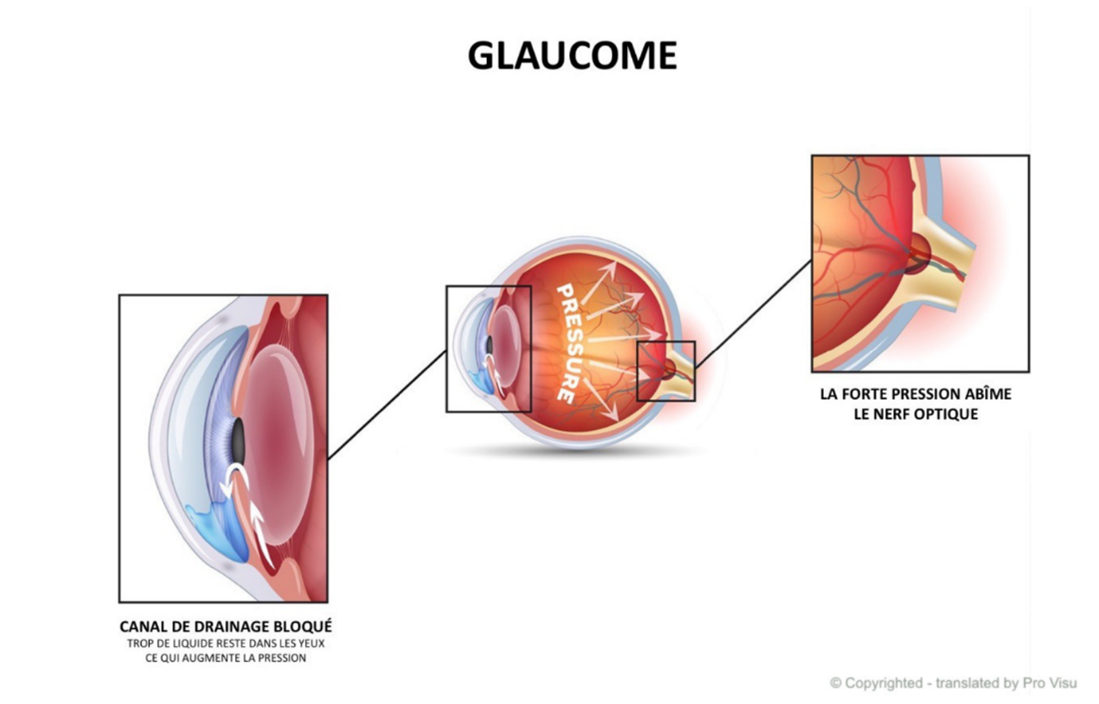Diseases
Glaucoma

Definition
Glaucoma is a serious disease caused by abnormal drainage of the aqueous humour (liquid contained in the eyeball). This causes the pressure in the eye to rise sharply, leading to slow destruction of the optic nerve and a progressive reduction in vision, which begins at the periphery of the visual field. However, central vision is preserved until the disease reaches an advanced stage, which can make it silent for many years. Medical monitoring is necessary, because if left untreated, the affected eye can lose all of its visual capacity. Glaucoma is one of the leading causes of irreversible blindness worldwide.
There are different forms of glaucoma:
- Primary glaucoma, of which a distinction must be made between open-angle glaucoma (or chronic glaucoma) and angle-closure glaucoma (or acute glaucoma). Open-angle glaucoma is the most common, accounting for 80-90% of cases. It develops gradually, unlike the second, which is much rarer and develops suddenly in one eye.
- Secondary glaucoma, which results from eye conditions or diseases such as diabetes, thrombosis or inflammation of the eye.
- Glaucoma in children, which includes early-onset infantile glaucoma (in newborns), infantile glaucoma (up to one year of age) and juvenile glaucoma (from one year of age to adolescence). This category of glaucoma is often hereditary in origin.
Causes
The cause of glaucoma is often difficult to pinpoint, although the main risk factor is high eye pressure (although 9 out of 10 people with high pressure do not develop glaucoma).
The following risk factors can also be attributed to glaucoma:
- Age (increased risk from the age of 40)
- Genetic predisposition
- Significant myopia or hyperopia
- Ethnic origin (African and Hispanic)
- diabetes
- High blood pressure
- Ocular trauma
- Inflammation or abnormality of a blood vessel
- Certain medications such as cortisone
It is therefore important to make an early diagnosis in people with one or more of these risk factors.
Symptoms
Open-angle glaucoma
In the majority of cases, there are no warning symptoms. The disease develops silently over a period of 10 to 20 years, which is why this type of glaucoma is particularly difficult to detect unless a full eye examination is carried out.
The warning sign is the development of blind spots, which gradually obstruct peripheral vision and lead sufferers, for example, to miss a step on the stairs, notice missing letters in words or have difficulty driving. Central vision, on the other hand, is preserved for a long time (people with glaucoma have tunnel vision, i.e. they see very well in front of them but are blind in other directions). Both eyes are affected, usually more severely on one side than the other, allowing the stronger eye to compensate for the loss of vision. All too often, the diagnosis is made when the glaucoma has already reached an advanced stage and irreversibly narrowed the visual field.
Angle-closure glaucoma
In this type of glaucoma, the disease develops suddenly and affects just one eye, causing intense pain in the eyes and head, a multicoloured halo around light sources and a deterioration in vision. Nausea and vomiting may also occur. The eye is often red and hard and requires urgent ophthalmological consultation, as without treatment, vision can be irreversibly lost in just a few hours.
Diagnosis
The earlier glaucoma is detected, the less damage there will be to the visual field. It is therefore vital to have regular check-ups with your ophthalmologist to avoid detecting glaucoma at an advanced stage, when part (or even all) of your vision has already been lost.
The recommendations are as follows:
- Screening every three years for the over-40s
- Screening every two years for the over-50s
- Screening every year for people over 60.
Glaucoma screening tests consist of :
- measurement of intraocular pressure using a tonometer
- Examination of the back of the eye to study the condition of the optic nerve
- Assessment of the visual field to measure the ability to see the peripheral space without moving the eyes
- Examination of the iridocorneal angle to determine the type of glaucoma.
Treatments
It is not yet possible to cure glaucoma, but a number of treatments can slow (or even halt) its progression by lowering intraocular pressure.
There are three types of treatment:
Eye drops, which must be administered regularly and for life.
Laser surgery, called trabeculoplasty, for chronic open-angle glaucoma. It is performed under local anaesthetic, is painless and involves evacuating the aqueous humour. One month later, intraocular pressure is measured to determine the effectiveness of the procedure. Surgery may be necessary if the reduction in intraocular pressure has not been sufficiently significant.
Surgery is carried out under local anaesthetic and often requires an overnight stay in hospital to control the intraocular pressure. During the two weeks following the operation, you should refrain from carrying heavy loads and doing sport.
Even if the intraocular pressure is normalised thanks to these treatments, the disease is not yet over. It requires lifelong monitoring, as it can continue to progress. Ophthalmological check-ups are therefore necessary every 3 to 6 months.
Frequency
Glaucoma affects 64 million people worldwide. It is the second leading cause of blindness in industrialised countries, just after age-related macular degeneration (AMD). However, only 50% of people with glaucoma know they have it.
Glaucoma affects both men and women and can occur at any stage of life, although advanced age is a risk factor (glaucoma is six times more common in people over 60).
Prevention
There is no specific prevention, but regular screening is recommended, especially in the presence of known risk factors.
References
Secrétariat Glaucome - Hôpital ophtalmique Jules-Gonin
glaucome_traitements.pdf (hug.ch)
Glaucome - symptômes, causes, traitements et prévention - VIDAL
Glaucome - Troubles oculaires - Manuels MSD pour le grand public (msdmanuals.com)
Contenu revu et contrôlé le 27.04.2023.

